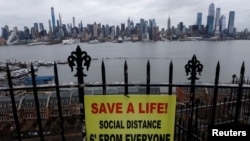Everyone in the United States should be under orders to stay home in order to stem the spread of the coronavirus pandemic, National Institute of Allergy and Infectious Diseases chief Anthony Fauci told CNN on Thursday.
With nearly 300,000 infections and close to 7,000 deaths, the U.S. COVID-19 toll is the largest in the world.
But 12 states have not issued these orders, and President Donald Trump has resisted issuing a nationwide directive.
"If you look at what's going on in this country, I just don't understand why we're not doing that," Fauci said.
While Alabama, Missouri, Oklahoma, Texas, Utah, Wyoming and South Carolina have no statewide orders, cities and counties within those states have issued them. Five states -- Arkansas, North Dakota, South Dakota, Nebraska and Iowa -- have no orders at the state or local levels.
Estimates that tens or even hundreds of thousands of Americans will die are based on governments implementing, and citizens following, social distancing policies. The longer those measures are delayed, the higher the estimates get.
People traveling from areas that do not have restrictions can seed new outbreaks in areas that do.
The states that have not issued stay-at-home orders are largely rural. The largest outbreaks so far have been in urban areas: New York City, Seattle, Los Angeles.
"These things aren't all apples to apples," Nebraska Gov. Pete Ricketts, who has declined to issue an order, said.
"There are some states that don't have much of a problem," Trump told reporters Wednesday.
That's a dangerous assumption to make given the fact that both the number and accuracy of tests are falling far short, Harvard University immunologist Yonatan Grad said.
"Our estimates of the number of cases are almost certainly wrong," he said. "We are underestimating the number of cases that are really out there, and we don't know by how much."
Isolation may have protected rural communities somewhat so far. "It just takes more time to show up there," Grad said. "But it will."
Plus, there is a lag of several weeks between when cases start to appear in official tallies and when the peak hits. And COVID-19 has demonstrated in China, Italy, Spain and New York City that it can quickly overwhelm the health care system.
"The sooner you're able to slow the spread of the virus, the more you're able to flatten the curve and mitigate the risk to your health care infrastructure,” Grad said.
When it does hit, rural areas are likely even less prepared than their urban counterparts.
In small towns in eastern Washington, for example, "there's only one doctor or two doctors," University of Washington epidemiologist Ali Mokdad said. "We can't afford to have it there."
In Missouri, major cities and a growing number of smaller communities have issued stay-at-home orders. But without a statewide order, much of the rural state is not covered.
"If you get this illness in one of these rural communities, they're going to have to go to the urban centers to be cared for,” infectious disease physician Jason Newland, at Washington University in St. Louis, said.
States reluctant to issue orders are relying on citizens to take personal responsibility and follow recommendations to stay home.
“It’s a community effort, everybody pitching in makes everybody safer and protects the elders and vulnerable people in our community," James Lawler, co-director of the University of Nebraska Global Center for Health Security, said. Lawler is advising Nebraska's Gov. Ricketts.
"If we all make the effort and work together, then we’ll be successful," he told The Omaha World-Herald.
But government orders carry more weight than recommendations, Newland, of Washington University, said.
"I think we all know a recommendation and an order are pretty different things in someone's mind," he said. "An order is like, 'Oh, I guess they're really serious about this. This is a whole other level.' "
Data from the United Kingdom bear that out.
At the beginning of the outbreak, the government advised social distancing but didn't require it. Restaurants and bars stayed open. Scientists studying population movement using cellphone and other data didn't notice much of a change in people's behavior.
"We didn't see big drops until it actually became government policy," University of Southampton epidemiologist Nick Ruktanonchai said.
Washington state had the first COVID-19 case in the United States and the first big outbreak. It was also among the first to close schools and cancel large events.
These measures are working, Mokdad said.
"In my own state, what we have projected early on for mortality, we're seeing smaller numbers coming up," he said.
The economic consequences of the shutdowns are devastating. However, "it's also important to understand that there are huge economic consequences to not doing so," Harvard's Grad said.
When the outbreak explodes and overwhelms the health care system, "we won't have the infrastructure to treat the people with heart attacks, to treat the people who have strokes, to treat the people who have appendicitis and need to go in for surgery," he said.
"It's quite natural to understand why people want to say, ‘Look, we don't see it now. Why do we have to do anything?’ " Grad said.
"Look at what happened in northern Italy. Look at what happened in Spain. Look at what's going on in New York City," he said. "That is what we can all anticipate."











